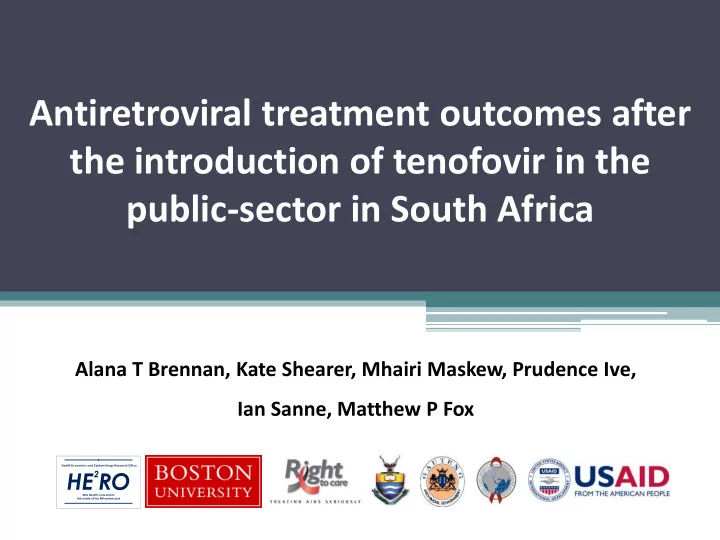

Antiretroviral treatment outcomes after the introduction of tenofovir in the public-sector in South Africa Alana T Brennan, Kate Shearer, Mhairi Maskew, Prudence Ive, Ian Sanne, Matthew P Fox Health Economics and Epidemiology Research Office HE RO 2 Wits Health Consortium University of the Witwatersrand
Background • Prior to the South African National Guidelines changing in April 2010, stavudine was the most frequently used nucleoside reverse-transcriptase inhibitor (NRTI) • In 2010, the South African government revised its HIV treatment guidelines to substitute stavudine with tenofovir: ▫ Initiate all newly diagnosed patients eligible for treatment on tenofovir-based regimen ▫ Patients currently on stavudine-based regimens: remain on stavudine if well tolerated substitute at first sign of toxicity substitute immediately if at high risk of toxicity: high body mass index, low iron levels and older females
Single-Drug Substitutions Analysis Investigated: Trends in single-drug substitutions from 2004 to 2011. Single-drug substitution: changing one or more drugs within first-line therapy without initiating a protease inhibitor - excluded all switches to second-line therapy. Drug Substitution Initiating ARV 2004-2010 2010-present zidovudine tenofovir stavudine abacavir zidovudine abacavir stavudine tenofovir NRTI/NtRTI zidovudine abacavir stavudine abacavir not available stavudine tenofovir zidovudine abacavir efavirenz nevirapine nevirapine NNRTI nevirapine efavirenz efavirenz
Methods - Single-drug Substitution • Prospective cohort study: ▫ Themba Lethu Clinic, Johannesburg, South Africa ▫ Included 19,699 HIV-positive adult patients: ART-naïve, non-pregnant, initiated standard first-line ART between April 2004 and December 2011. • Analysis: ▫ Cox proportional hazards models to evaluate 12-month outcomes: Model 1: association of year of initiation onto ART and single-drug substitution to look at trends over time Model 2: association of type of antiretroviral drug in first-line ART and single-drug substitutions
Methods - Sub-analysis of Stavudine (30mg) vs. Tenofovir • Prospective cohort study: ▫ Included 4333 ART-naïve, non-pregnant, HIV-positive adult patients newly initiated on to either: stavudine-based first-line regimen (April 2009-March 2010) (n=2214) tenofovir-based first-line regimen (April 2010-March 2011) (n=2219) • Analysis: ▫ Outcomes at 24-months on ART: All-cause mortality (death registry) Cox proportional hazards model Lost to follow-up (at least 3-months late for the last scheduled visit) Fine and Gray’s regression method Mean CD4 change from ART initiation linear regression Detectable viral load (>400 copies/mL) log-binomial regression
Results – Frequency of single-drug substitutions in the first 12-months on ART by year of ART initiation 13.2% 5.8%
Results (cont.) - Single-drug Substitution Rates / Crude Hazards Ratio Adjust Hazards* 100 pyrs (95% CI) Ratio (95% CI) MODEL 1 Year initiated onto ART 2004 vs. 2011 8.2 (6.7-9.9) 1.1 (0.9-1.4) 1.1 (0.8-1.4) 2005 vs. 2011 13.7 (12.0-15.5) 1.9 (1.5-2.3) 1.8 (1.5-2.2) 2006 vs. 2011 13.5 (12.0-15.1) 1.9 (1.6-2.3) 1.8 (1.5-2.2) 2007 vs. 2011 16.5 (14.8-18.3) 2.3 (1.9-2.8) 2.2 (1.9-2.7) 2008 vs. 2011 12.5 (11.0-14.2) 1.7 (1.4-2.1) 1.7 (1.4-2.1) 2009 vs. 2011 13.9 (12.5-15.5) 1.9 (1.6-2.3) 1.9 (1.6-2.3) 2010 vs. 2011 12.9 (11.5-14.4) 1.8 (1.5-2.2) 1.8 (1.5-2.1) MODEL 2 NRTI/NtRTI 17.2 (14.4-20.6) 3.0 (2.3-3.9) zidovudine vs. tenofovir 2.3 (1.9-2.9) 16.3 (15.4-17.2) 2.8 (2.2-3.5) stavudine (30mg) vs. tenofovir 2.1 (1.8-2.4) 21.6 (19.6-23.7) 3.8 (2.9-4.8) stavudine (40mg) vs. tenofovir 2.8 (2.3-3.2) NNRTI nevirapine vs. efavirenz 21.5 (19.1-24.2) 1.5 (1.3-1.7) 1.5 (1.3-1.7) *Adjusted for demographic (age and gender) and clinical characteristics at ART initiation (CD4 count, hemoglobin, BMI, tuberculosis, WHO stage)
Results – Sub-analysis of Stavudine (30mg) vs. Tenofovir Adjusted Relative Risk Number events Rates / (%) 100 pyrs (95% CI) Mortality tenofovir 128 (6.1) 3.8 (3.1-4.4) Reference stavudine (30mg) 234 (10.6) 7.3 (6.4-9.3) 1.5 (1.2, 1.9) Loss to follow-up (defined as at least 3-months late for the last scheduled visit) tenofovir 411 (19.4) 12.1 (10.9-13.3) Reference stavudine (30mg) 403 (18.2) 12.6 (11.4-13.9) 1.2 (0.95, 1.30) Detectable Viral load (unsuppressed >400 copies/mL) tenofovir - 443 (20.9) Reference stavudine (30mg) - 504 (22.8) 1.1 (0.95, 1.30) Mean Difference (95% CI) 3 ) CD4 response (cells/mm 3 (-6.2, 17.0) stavudine (30mg) vs. tenofovir 5.4 cells/mm *Adjusted for demographic (age and gender) and clinical characteristics at ART initiation (CD4 count, hemoglobin, BMI, tuberculosis, WHO stage
Conclusions • The decline in single-drug substitutions in the first 12-months on ART appears to be related to the introduction of tenofovir, resulting in fewer drug toxicities. • Although comparable in regards to loss to follow-up, mean change in CD4 count and viral load status by 24-months on ART patients initiated onto stavudine may have higher mortality than those on tenofovir. • Despite the increased cost, the use of tenofovir could help improve long-term treatment outcomes in HIV-positive patients.
Acknowledgments Funding was provided by USAID under the terms of Cooperative Agreement 674-A-00-09-00018-00 to Boston University and Cooperative Agreement 674-A-00-02-00018 and CA 674 A 00 08 0000 700 to Right to Care; INROADS USAID-674-A-12-00029 and the National Institute of Allergy and Infectious Diseases (NIAID) Award Number K01AI08309. This study is made possible by the generous support of the American people through the United States Agency for International Development (USAID) and the National Institutes of Health. The contents are the responsibility of the authors and do not necessarily reflect the views of US AID, NIH or the United States government. Health Economics and Epidemiology Research Office HE RO 2 Wits Health Consortium University of the Witwatersrand
Recommend
More recommend